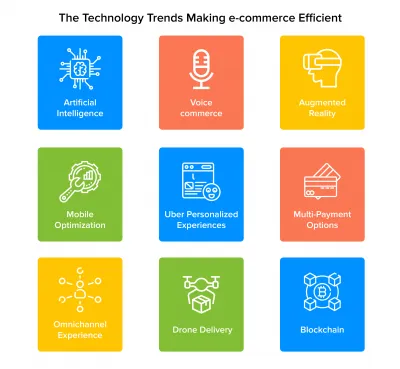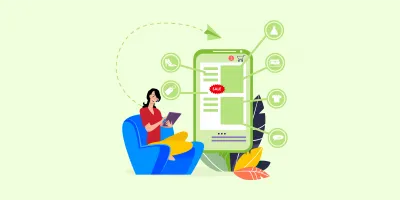Technology Trends That are Helping E-Commerce Business
Blog: NASSCOM Official Blog

The e-commerce sector is evolving by leaps and bounds. By the time 2019 ended, the global e-commerce market had registered a sales of $3.5 trillion – a figure that experts predict to reach $4.2 trillion by the end of 2020. This monstrous growth that the industry witnessed didn’t happen in isolation. Several technologies played a role in marking their success. Let us, deep-dive, into some of the e-commerce app development technology trends designed to make the sector more efficient.
While it was a foolish assumption that with the rate tech world is flourishing, its impact on the e-commerce industry has become stagnant, it was difficult for anyone to understand the depth of the impact. Time and again, new technology or new use cases are emerging in the sector with the promise of making it efficient and customer-centric.
Although it is difficult to say with utmost guarantee which technology would truly revolutionize the high-interest domain, going by the current state it is safe to assume that reformation of the e-commerce industry will not be the work of one technology but many.
Here are some of the technological trends that are making the sector a revenue magnet.
The Technology Trends Making e-commerce Efficient

1. Artificial intelligence
When we compare the experience of shopping online with the one where we shop from brick-and-mortar retail stores, the only pivotal difference comes in terms of a lack of personalized guidance.
For bridging the gap between online and offline customer experience, several businesses have started working towards the incorporation of Artificial Intelligence. The technology, through the mode of a virtual assistant, can direct customers towards the best product offers by asking them questions about their preferences and needs.
Besides the promise of adding uber personalization in the e-commerce app development efforts, AI also helps businesses:
- Understand their customers’ needs
- Transform customers’ data into real-time insights for bettering the shopping experience
- Automate customer support, thus helping customers 24*7
- Optimize distribution and pricing
- Predict demand forecasting that enables making smart ad spending decisions.
2. Voice commerce
Voice assistants are seeing their use cases getting expanded beyond checking the weather, operating smart home devices, or searching fun facts on Google. They are seeping into the e-commerce domain at a substantial speed, reducing customers’ efforts in making a purchase.
Google Assistant, Siri, and Alexa are already helping people purchase products on the go – contributing to the projection of 38 million people making purchases through smart speakers by 2021.
Brands across different e-commerce sectors have started optimizing their apps and websites according to the voice specific keywords. Although still at its nascent stage, brands have started experimenting, researching, and running A/B tests for determining how to get maximum reach through voice search.
3. Augmented Reality
It is nearly impossible to talk about e-commerce technology trends and not mention augmented reality. The one major benefit of brick-and-mortar shopping lies in giving people a physical experience – they can see how a dress looks on them or imagine how a decor item would look in their home.
AR, by giving people a tool for trying out clothes and placing a decor item in their space virtually, helps blur the difference in online and offline retail space. In its present state, AR is gaining popularity among furniture retailers enabling people to test out the look of their new couch or side table inside their home through nothing but their smartphone.
Gartner projects that over 100 million customers will use Augmented Reality for shopping by 2020. In another survey, it was noted that over 35% of respondents mentioned that they will be shopping through online mode more if only they could virtually try a product before purchasing it. Additionally, 22% mentioned that they are less likely to visit a brick-and-mortar retail house if Augmented Reality functionality was present in their preferred e-commerce platform.
4. Mobile Optimization Will Become a Priority Task
While it is not a surprise that mobile apps are changing the e-commerce landscape for the good, statistics like one estimating by 2021 end 73% of the e-commerce sales will happen on mobile validate the need for retail houses to be on mobile devices even further. As we near 2021, e-commerce businesses have started prioritizing the optimization of their stores for the mobile phone arena.
When optimizing for smartphone users, they have started focusing on minimizing the clicks, creating an intuitive search process, making the checkout process easier. All these feature sets are designed to make the steps involved in bringing efficient shopping experience on small devices a breeze.
Businesses have also started partnering with e-commerce app development agencies for creating solutions that would help them take advantage of devices’ in-built features like camera, GPS, microphone, etc. for better customer experience.
5. Uber Personalized Experiences
The link between personalized experiences and greater sales numbers is getting stronger than ever before. Businesses have started fetching in data from omnichannel customer touchpoints and are analyzing those data for creating insights into their customers to an extent that they know the websites they visit, the kind of items they search online, and their buyer sentiment towards a product or service.
Today’s top e-commerce platforms understand that there is an increasing competition in the sector and the only way for them to earn brand loyalty is to use personalization to show that they understand their customers, without coming across as creepy.
There are multiple options for knowing your customers – analytics software, survey tools, social media analysis, etc. Businesses are not shying away from using any of these platforms and experimenting with other platforms and toolsets.
6. Multi-Payment Options
Customers are constantly looking for new ways to make payments – ones that are a mix of high security and fewer steps. They have grown fond of using Walmart and Amazon for their shopping needs. These e-commerce platforms save their billing and shipping data making the checkout process easy and fast without making them perform extensive data entry tasks.
In addition to the ease, modern shoppers are more willing than their predecessors when it comes to using third-party payment platforms integrations like wallet, Apple Cards, etc.
Joe Chilson from 1Digital Agency sees payment centralization taking a front seat in the e-commerce domain in 2020 and for some years after that. He says, “Think about how easy it would be to buy a product on any website if, at checkout, you could simply give them an ID unique to you. This unique ID would be for a centralized wallet service that would securely store all your payment info, shipping and billing addresses, preferences, etc. Companies like Apple and PayPal have taken shots at this in the past, but I think it could become more normalized.”
7. Greater Focus on Omnichannel Experience
Although not specific to any individual technology, omnichannel is a profitable event that can best be leveraged by connecting multiple platforms through APIs or IoT and then using the gathered information to create valuable insights through the use of AI.
An omnichannel experience is designed by implementing a multi-channel approach for serving customers and marketing products in a way that connects user experience across different platforms, irrespective of how a customer reached out to a business.
Several top brands vouch for omnichannel marketing as an active success factor behind their business growth and continued profitability. Some of those commonly heard names are Starbucks, Disney, Bank of America, REI, Virgin Atlantic, amongst others.
8. Drone Delivery
Using drones commercially for making deliveries has already begun at a low-scale. Drones, when seen as an alternative to local deliveries, tend to be a lot more cost-efficient and speedy compared to traditional delivery models. In the coming time, we are poised to see drones becoming as common as delivery trucks on roads.
Although at a very nascent stage currently, multiple research has started happening in the domain with the hope of making them an industry norm.
9. Blockchain Making the Sector Transparent
With the amount of data that the e-commerce sector works with and the unprecedented importance of the supply chain, the inclusion of Blockchain technology in the industry is nothing less than a natural fit.
Cryptocurrencies can act as an alternative payment method for secure and faster inter-geographies transactions. It can also play a huge role in improving the process of shipment tracking and order fulfillment.
Many Blockchain-powered companies are working on giving sellers and buyers an efficient edge in their shopping experience – ECoinmerce, EVERY*, Shopin, etc being the most renowned ones of them.
The Last Words
When you sit down to read the success stories of some of the best e-commerce platforms, you will find technology incorporation to be a major part of their growth chart. Whether you look at eBay or Amazon, or even Neiman Marcus, you will find them exploring multiple technologies and an experimentative set of their use cases. For a business that is just getting off the ground, we recommend partnering with an e-commerce software development company and finding ways to incorporate technology for creating a competitive advantage.
The post Technology Trends That are Helping E-Commerce Business appeared first on NASSCOM Community |The Official Community of Indian IT Industry.
